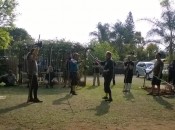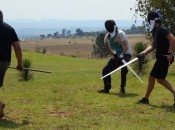
Most of what we train in HEMA revolves around one-on-one combat, but it is instructive to train multiple opponent scenarios every now and then, Off the top of my head, here’s a few reasons to do so:
– Fighting multiple opponents develops situational awareness
– Fighting multiple opponents emphasises the basics underlying our art, particularly timing and footwork
– Fighting multiple opponents is fun!
There are, of course, a couple of caveats as well:
– Multi-person fights are messy, and care must be taken with safety
– Multi-person fights only use a small part of the fighter’s repertoire (see below)
– Things happen fast; such fights are not really good learning environments for beginning students
All said, I’d like to talk through some observations on some recent multiple opponent games we have played. We have been playing multiple opponent scenarios using synthetic backswords, because then we can pull together the biggest pool of fighters in the club, as the longsword and rapier groups both smaller. Furthermore, not everybody has the protection needed for steel longsword games. Thus, the observations I make are only really applicable to one-handed cutting weapons.
The theory
Not too many period sources deal with multiple person combat, but there is some info out there. The Döbringer manuscript probably has the most advice, but starts out not terribly optimistic, declaring
– “It is no shame to flee when four or six (foes) are at hand”
– “If you want to beat five or six men, then you will often get badly hurt since you can’t defend against every strike directed against you, and you will then be subjected to ridicule and scorn.”
– “This is not great courage, but great stupidity to try for four or six [opponents]; this will become clear to you that you will get the very opposite just as if you had bought it.
It is better to hide away in a bed than to display such great clumsiness. But it happens that you may defend against four or six, if you are careful, and if you behave chivalrously
and you part well from them then you will defend well against all.”
(from the translation by David Lindholm)
However, a later section has a lot of advice:
(44v- 45v)
Here rightly begins the very best fencing by the aforesaid master know, this I tell you that it is called the iron gate [Eyseryne pforte], which you will understand soon.
If you are set upon by four or six peasants, then place either foot forward and with the gate you will create a shield by placing the point towards the ground.
Hear how you should do this, place yourself so that they are right in front of you and that no one can get in behind you.
Now hear what you should do, when they strike or thrust at you, set them aside [Abesetzen] with strength going up from the ground and then you will shame them well.
Then do the peacock’s tail [Pfobenczagel] against them, and then no one can remain in front of you.
Strike below while defending and deflecting well. Strike briskly with the changing strike [Wechselhewen] and use the Weed Hoe [Krawthacken] as well, and then you will truly press them.
But I do advise everybody not to remain standing right in front of him (the opponent) unless you want to be a looser, but someone who hits.
Against someone who comes at you from the left side, step towards him quickly and strike at him so that he cannot deflect [Abelecken] and if they keep on coming as before, then do as before and you will not fail.
Strike one after the other, just make sure that they can’t get at you all at once, and then you will be without danger.
As you have understood from the foreword it is possible for a man to stand against four or six that wants to win. That is why I advise you to follow my teachings, meaning that you quickly attack the ones on the outer ends before the other turns against you, then they will have to turn after you since you are leading.
Then you can well notice when it is or is not safe to move away from the opponent and then leap away from him as I say. There is no hurt or disgrace to run away from four or six. And when you turn and start to run away from him, then throw your sword across and run as fast as you can.
Then as one who thinks that he has caught up with you and has closed with you, then leap to the side of the road and if he is running quickly after you, then he will be moving too fast to control himself and you can strike him down as you wish.
(from the translation by David Lindholm)
Interpreting this section, several ideas are present:
– Don’t be ashamed to run away when the numbers are too great!
– Don’t let everybody attack you at once, and don’t let anybody get behind you
– Counter an attack by stepping towards the opponent and “strike so that he cannot deflect”
– Don’t stay stationary, but move constantly.
Many of these ideas are mirrored in Luis Preto’s book “The forgotten art of fighting against multiple opponents”. Though Luis comes from a Jogo do Pau background, the advice on multiple opponents is still applicable to HEMA, and boils down to the following:
1) Control the distribution of the opponents
2) When an opponent approaches, attack towards that opponent, looking to interrupt him mid-tempo
3) Use large sweeps to control the space
4) Move from opponent to opponent, don’t concentrate on only one.
A couple of the rapier masters also deal with multiple opponents, and Piermarco Terminiello does a good job of going through such sources here.
Practical observations
So there is some theory about fighting multiple opponents, but what actually happens in practice? Well, we have run a number of fights, and I can make some observations.
Firstly, the rules. In these fights, we use a variation of the HALAG rules. Every person declares hits on themselves. A person is killed by a strike to the head (cut or thrust) or a thrust to the chest. A person can take one hit to other areas (“an injury”) and remain fighting, but a second injury knocks them out. A defeated attacker sinks to his knee, indicating he is done. And your partners’ swords will kill you!
Secondly, the obvious caveats. We’re not using sharp swords, so fighters may not react the same way as a fight to the death. The fighters also have some experience, so we’re not exactly doing “peasants against knights”. We don’t coach the group of attackers, but obviously some strategies do evolve. The space we use isn’t enormous (half the hall), so different conclusions could come about in wider space.
Anyhow, here’s the observations:
1 vs 2
The simplest scenario involves one “defender” facing off against two “attackers”. Observations:
1) The attackers naturally split up and arrange themselves at 90 degrees to the single fighter. This comes about as the single fighter strives to prevent one fighter getting behind him, and as the attackers spread out to avoid their partners arc.
2) The defender can use sweeping cuts to keep himself safe, but will eventually get overwhelmed.
3) The big secret for the defender is to pick the correct opportunity to follow up a parry with an attack. As the attack opens the defender up to the second opponent, it really needs to be timing correctly.
4) Patient attackers win, impatient attackers often die.
5) I’d estimate that the single fighter wins the game maybe 20% of the time. Interestingly, in this scenario, many really competent fighters struggle as the defender, as their programmed reactions (parry and thrust, aggressive attack, etc.) tend to open them up to the other attacker.
1 vs 3
This scenario plays out surprisingly similar to the 1 vs 2 scenarios. Why? Because two attackers end up engaging the opponent, leaving one attacker to circle behind/ lurk. If the defender takes up space in a corner, only two opponents can really attack. If the defender doesn’t control the environment, the singleton attacker finds it reasonably easy to sneak up behind, and either “kill” the defender or distract him to create an opening.
Chance of success for the defender- very low!
2 vs 3
This scenario pits two “defenders” against three “attackers”. This is probably the most fun scenario, partly because tactics plays a bigger role and the defenders and attackers are more evenly matched. There are some surprising observations though:
1) The fight normally splits into “1 vs 2” and “1 vs 1”. However, if the two defenders take care not to be split, one of the attackers tends to find himself squeezed between his partners, so the “1 vs 2” tends to be constrained by space
2) The “middle” attacker normally dies. If he and a partner attack one defender, he tends to expose himself to the other defender. At the same time, the “middle” defender has limited space to step and swing.
3) The “1 vs 1” fight determines the outcome in most circumstances. The defender can often drive the attacker into the attacker’s partners and otherwise mess with things.
4) I’d reckon the defenders (2 people) win just more than half the time. The extra person really constrains the attackers, and the attackers need to actually need to develop a strategy for using their numerical advantage (possibly assign the middle man a different role).
Discussion
We’ve probably only scratched the surface of the multiple opponent scenario. I’m sure we’ll find many more strategies and tactics for dealing with these scenarios, but hopefully this article will stimulate some discussion. Internally within the club we haven’t paid a lot of attention to tactics for the attackers, which is an obvious area of interest. Can two attackers learn to operate together? Can we teach trios to gang up on a single attacker, rather than the current “2 vs 1, plus extra lurker”? Can we sort out the “middle attacker” problem in the 3 vs 2 scenario? At what level do we move from multiple attackers to small group tactics?
At the same time, all of us could use more time as a single defender. Our spatial awareness and reactions need to be adjusted for the experience, and some of our personal flaws become much more prominent when there are several attackers. My own experience is that I go from omnipotent sword god to useless in the multiple opponent games, so I know there’s a lot of work to be done (and a lot of fun to be had!).





